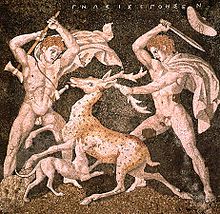- Stag Hunt Mosaic
-
The Stag Hunt mosaic (c. 300 BCE) by Gnosis is a mosaic from a wealthy home, the so called "House of the Abduction of Helen" (or "House of the Rape of Helen"), in Pella, the capital of the Macedonian Kingdom.
Composition
The emblema is bordered by an intricate floral pattern, which itself is bordered by stylized depictions of waves.[1] The mosaic is a pebble mosaic with stones collected from beaches and riverbanks which were set into cement.[2] As was perhaps often the case,[3] the mosaic does much to reflect styles of painting.[4] The light figures against a darker background may allude to red figure painting.[5] The mosaic also uses shading, known to the Greeks as skiagraphia, in its depictions of the musculature and cloaks of the figures.[6] This along with its use of overlapping figures to create depth renders the image three dimensional.
It is often wondered if Gnosis, whose signature ("Gnosis epoesen", i.e. Gnosis created) is the first known signature of a mosaicist,[7] could have been the painter of an earlier picture which the mosaic reproduces, rather than the mosaic-setter. In the case of pottery, 'epoesen' referred to a maker of the pot while 'egraphsen' was the verb used to designate the painter.[8] Therefore, if an analogy to pottery is warranted, it seems likely for Gnosis to have been a mosaicist. Since gnosis (Greek: γνῶσις) is also the Greek word for knowledge, others have said the inscription does not refer to an author at all; but to an abstract pronoun.[9][10]
The Figures
The figure on the right is possibly Alexander the Great due to the date of this mosaic along with the depicted upsweep of the hair.[11] Pella is also the birthplace of Alexander. The figure to the left wields a double-headed axe, likely alluding to Hephaistos; meaning the figure depicted could be the general Hephaestion.[12] The dog depicted is possibly Peritas accompanying Alexander.[13]
References
- ^ Kleiner, Fred S., and Helen Gardner. Gardner's Art through the Ages. the Western Perspective. Boston, MA: Wadsworth Cengage Learning, 2010. pg. 135
- ^ Ibid
- ^ http://www.thejoyofshards.co.uk/history/index.shtml
- ^ Kleiner and Gardner, pg. 136
- ^ Ibid
- ^ Ibid
- ^ Mosaics of the Greek and Roman world By Katherine M. D. Dunbabin pg. 14
- ^ Mertens, Joan R. . How to Read Greek Vases. New York: Metropolitan Museum of Art and Yale UP, 2010. pg. 13
- ^ Cohen, Ada. Art in the Era of Alexander the Great: Paradigms of Manhood and Their Cultural Traditions. New York: Cambridge UP, 2010. pg. 32
- ^ Paolo Moreno thinks it was intended to be read as "Apelles' Knowledge Made It".
- ^ Chugg, Andrew. Alexander's Lovers. Raleigh, N.C.: Lulu, 2006. pg. 78
- ^ Ibid
- ^ Ibid, pg. 79
Categories:- Mosaics
- Ancient Greek art
Wikimedia Foundation. 2010.

